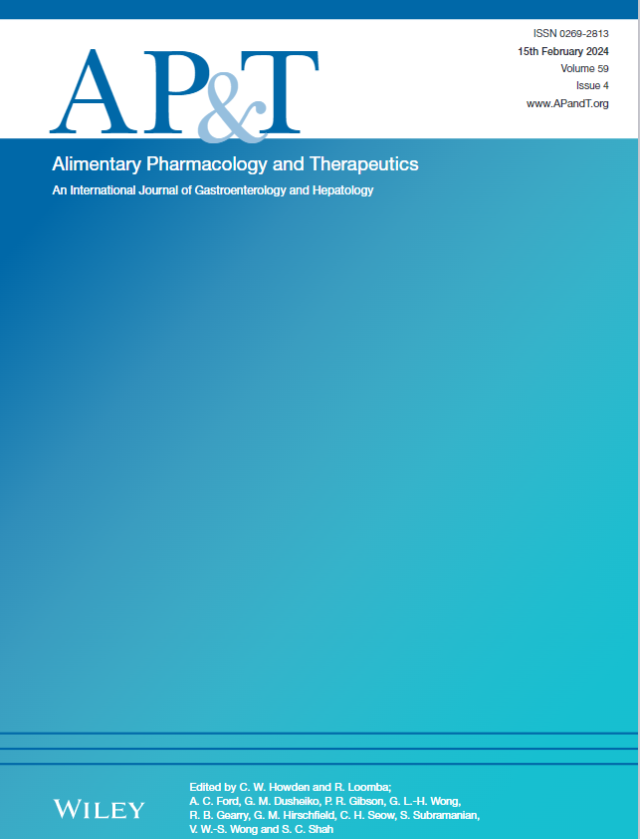Combined Lyon and Milan Scores Predict Gerd Management Outcome Better Than Either Score Alone or Their Individual Components
IF 6.6
1区 医学
Q1 GASTROENTEROLOGY & HEPATOLOGY
引用次数: 0
Abstract
BackgroundConfidence in gastro‐oesophageal reflux disease (GERD) diagnosis is crucial to improve outcomes from escalation of treatment. The Lyon score phenotypes patients through endoscopy and pH‐impedance (MII‐pH). The Milan score quantifies antireflux barrier through high‐resolution manometry (HRM) parameters.AimTo explore the relationship between the Lyon and Milan scores and their combined performance in predicting clinical outcomes.MethodsWe collected clinical and follow‐up data of consecutive patients with HRM and MII‐pH from nine centres. Clinical improvement was defined as a 50% reduction in global symptoms. The relationship between Lyon and Milan scores and the rate of patients improved in Lyon phenotypes and Milan categories were explored. The ability of the Lyon, Milan, DeMeester scores and acid exposure time (AET) in predicting outcomes was assessed through receiver operating characteristics (ROC) analysis.ResultsAmong 532 patients (50.6% female, age 50 years), 47.7% had pathologic GERD. A stepwise increase in the Milan score in Lyon phenotypes was observed. Sixty‐three patients had surgical treatment, and 131 medical. Clinical improvement in Lyon phenotypes Conclusive and Severe was 81% and 83%; in Milan categories very likely and extremely likely was 88.5% and 100%. If Lyon and Milan scores were positive, improvement was 89%; if discordant, 63%; if both negative, 19% (里昂和米兰的综合得分比单独得分或其单独组成部分更好地预测Gerd管理结果
背景:对胃食管反流病(GERD)诊断的信心对于改善治疗升级后的预后至关重要。Lyon通过内窥镜和pH -阻抗(MII - pH)对患者进行表型评分。米兰评分通过高分辨率测压法(HRM)参数量化抗反流屏障。目的探讨里昂和米兰的得分及其在预测临床结果中的综合表现之间的关系。方法收集来自9个中心的HRM和MII - pH患者的临床和随访资料。临床改善的定义是总体症状减少50%。探讨了里昂和米兰评分与里昂表型和米兰类别患者改善率之间的关系。通过受试者工作特征(ROC)分析评估Lyon、Milan、DeMeester评分和酸暴露时间(AET)预测预后的能力。结果532例患者中,50.6%为女性,50岁,47.7%为病理性反流。观察到在里昂表型中米兰得分逐步增加。63例患者接受手术治疗,131例接受药物治疗。里昂结论性和重度的临床改善分别为81%和83%;非常有可能和非常有可能分别是88.5%和100%。如果里昂和米兰的得分为正,则提高了89%;如果不一致,63%;如果都是负数,19% (p <;0.001)。ROC分析显示,Lyon评分的AUC为0.790,Milan评分为0.835,DeMeester评分为0.736,AET评分为0.741。结论里昂和米兰评分在预测胃食管反流患者预后方面优于AET和DeMeester评分。当它们一致时,它们提供最佳的预测准确性,指导治疗的升级。
本文章由计算机程序翻译,如有差异,请以英文原文为准。
求助全文
约1分钟内获得全文
求助全文
来源期刊
CiteScore
15.60
自引率
7.90%
发文量
527
审稿时长
3-6 weeks
期刊介绍:
Alimentary Pharmacology & Therapeutics is a global pharmacology journal focused on the impact of drugs on the human gastrointestinal and hepato-biliary systems. It covers a diverse range of topics, often with immediate clinical relevance to its readership.

 求助内容:
求助内容: 应助结果提醒方式:
应助结果提醒方式:


